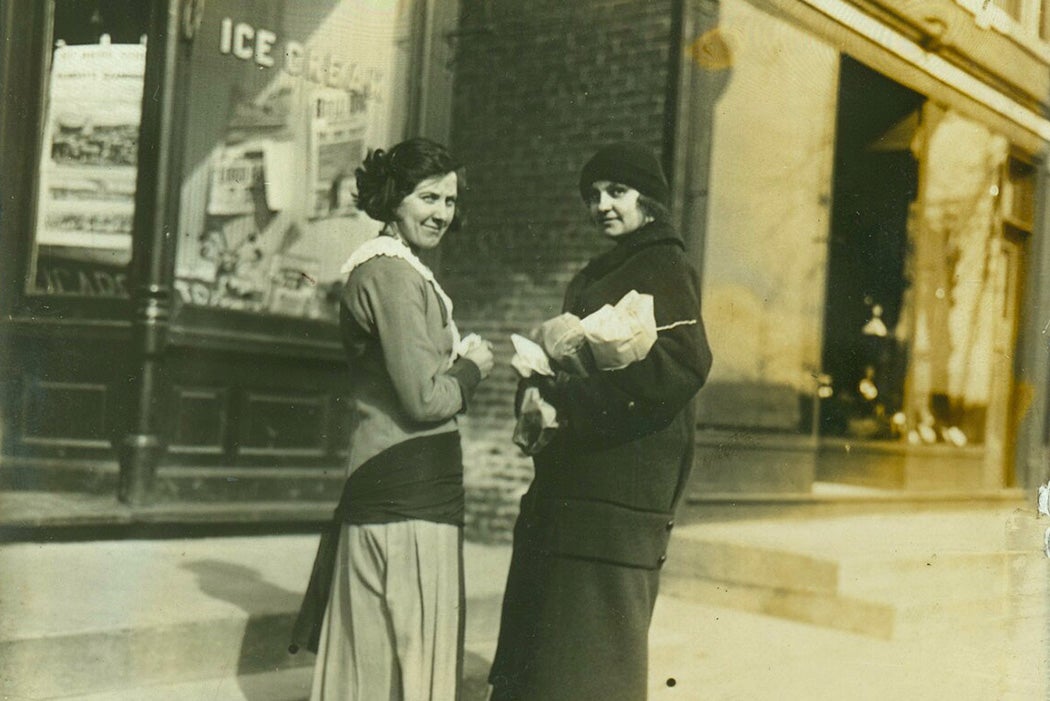Around 1910 there were few more dangerous places for a single white woman in a big city than the local ice cream parlor. Or so it was said. The rumors had some strong voices behind them. The US Attorney in Chicago, Edwin W. Sims, for instance, claimed he knew of more than two hundred cases of young white women who began their descent into prostitution because they had naively ventured into ice cream parlors. In Fighting the Traffic in Young Girls, or War on the White Slave Trade (1910), he warned: “One thing should be made very clear to the girl who comes up the city, and that is that the ordinary ice cream parlor is very likely to be a spider’s web for her entanglement.”
Yet Sims didn’t shut down any ice cream parlors for their supposed role in white slavery. What was going on?
Folklorist Bill Ellis explores the history of this politically charged urban legend. The year 1910 was the peak of the xenophobic white slavery panic. This was the widespread conviction that there was an epidemic of kidnapping of white girls and women into prostitution by foreigners and immigrants. Victims were supposed to be trafficked to other states or as far away as Istanbul or Shanghai. Perpetrators were almost always construed as Others, working in international gangs. Jews were blamed in Europe; Italians and other recent immigrants from the Mediterranean region were blamed in places like Chicago and New York.
And ice cream parlors in these cities were typically owned by immigrants from around the Mediterranean. Before ice cream became an epitome of Americana (supposedly accidentally invented by Martha Washington), it was what Ellis calls the “forbidden fruit of ethnic tourism.” The frozen treat was especially associated with Italians, who pioneered selling it on the street as “hokey-pokey” vendors and then in stores called parlors.
The name parlor came from the decorous part of the house where visitors were received. In particular, the home parlor was thought most suitable for visits by suitors. The home, of course, was easily chaperoned by parents. Ice cream parlors had no such chaperoning: this non-domestic space allowed single women to come and go as they pleased, eat on their own, or with friends, including male ones. The independent woman consumer unnerved traditionalist guardians of female sexuality.
The combination of un-chaperoned women and the “dens” of “swarthy” foreign ice cream sellers were an explosive combination amidst the racial fantasies of the day. Especially since there were so many single white women out and about on the urban scene, attending colleges and joining the workforce.
“Ice cream parlors are the places where scores of girls have taken their first step downwards,” insisted reformer Florence Mable Dedrick.
Yet ice cream was on its way to becoming an all-American food. Ice cream’s connections to the Mediterranean would be largely obscured, except for a nod by the “Neapolitan” combo of chocolate, strawberry, and vanilla. Like German apple pie and the French à la mode, not to mention the french fry, the exoticism of origins merged into generic “America food.” The melting pot of foodways, however, didn’t lessen the anti-immigrant politics that led to the 1924 restrictions on immigration from southern and eastern Europe.
Weekly Newsletter
The white slave panic itself petered out by the beginning of the First World War. It had a lasting influence in the White-Slave Traffic Act of 1910. Better known as the Mann Act, this made it illegal to transport girls or women across state lines and foreign borders for purposes of “prostitution or debauchery.” Sex-trafficking isn’t, of course, an urban myth, but Ellis notes that the Mann Act was never successfully used to prosecute an ethnic crime ring. (The act’s “immoral purposes” clause did become a potent weapon in enforcing sexual mores and, in particular, anti-miscegenation.)
This ice cream parlor/sex trafficking story may not seem so outlandish when compared to more recent “Pizzagate” fake news scandal. Instead of prostitution, this was supposedly about Satanic child abuse, a perennial urban legend militarized in this case by right-wing media. As its name suggests, Pizzagate centered on a pizzeria (a.k.a. …a pizza parlor), which vends a product that, unlike ice cream, has never lost its original immigrant associations.
Editor’s Note: This story was amended to fix a paragraph break.
Support JSTOR Daily! Join our new membership program on Patreon today.







